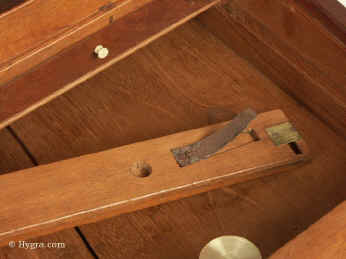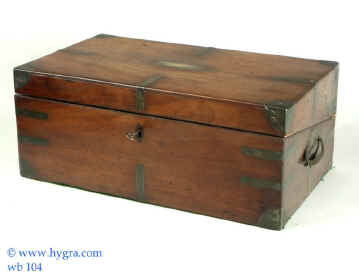Antique Irish Triple
Opening brass bound Mahogany Writing Box by Austen of Dublin circa 1830
Please click on images to enlarge | slide show | thumbnail index |
high resolution


 (Small).JPG)
|
There is a document wallet in
the lid. It is subtly blind embossed; that is no gold is used. Gold
embossing in the Dublin of that time would have been opulent display:
too flash.
This box is in such amazing
condition.
|
Please click on images to enlarge | slide show | thumbnail index |
 (Small).JPG)
|
The box opens down to an
embossed velvet (replacement) writing surface.
The upper part of the box
provides some privacy if writing with someone facing. The upper flap is
an early simple form.
|
| The Document wallet is made of fine Morocco leather |
 (Small).JPG)
|
Please click on images to enlarge | slide show | thumbnail index |
The box has the usual compartments for inkwells and a curved
pen tray.
There is a large place for storage of paper
There is a sprung panel concealing secret drawers.
|
 (Small).JPG)
|
 (Small).JPG)
|
The box is labeled:
GEO. AUSTIN
CABINET MAKER
7 St Andrew St.
One door from Exchequer St.
DUBLIN.
Manufacturer of portable writing
desks dressing cases. work boxes &etc.
Military Canteens & Plate Chests
George Austin moved to the
St Andrew Street Premises in1827
Over the years I have handled several boxes by him.
He is listed in the Jury Lists For the City of Dublin 1844 as the
"freeholder" of this premises.
He was one of the Exhibiters at the International
Exhibition in Kensington of 1862.
|
Please click on images to enlarge | slide show | thumbnail index |
 (Small).JPG)
|
The panel concealing the secret drawers is released by squeezing
the side in front between thumb and fingers.
|
As pressure is applied the sprung panel is released. The mechanism is
made entirely of wood.
|
 (Small).JPG)
|
 (Small).JPG)
|
This is unlike any English writing slope panel I have seen.
It is pine, of very straight grain. The cut of wood is quarter
The panel and the flaps are made of straight grained pine. This would
be unusual in an English made box of the period.
The freshness of the wood is exceptional.
|
It is interesting to compare this with an example from the same
period in London.

|
Detail of the sprung panel
which hides the secret drawers. The panel is released by inserting a
rod through a hole concealed by one of the inkwells.
|
Please click on images to enlarge | slide show | thumbnail index |
 (Small).JPG)
|
The secret drawers are of
dovetail construction.
|
In this image the secret drawer panel is part open.
The wood has no finish other than a little wax.
The wood on the side looks like ash.
Pine would be too soft for this purpose. The end-grain of the pine
would be resilient to wear.
An unusual feature is the brass pin in the facing. It would have
helped to prevent the box warping .
|
 (Small).JPG)
|
Reference: wb 104
Description:
An Early 19th C solid Mahogany writing box with elaborate and
unusual secret compartments screw-down mechanism and historical
asociations.
Origin:
English/Irish
Circa:1810
Materials: Mahogany
Brass
Size: 51 cm by 30 cm by 20.5 cm: 20.1 inches by 11.8
inches by 8.1 inches.
|
This is another Irish box of the same period.
The top has a brass plate inscribed "Colonel L'Estrange
K.C.M"
The L'Estranges are an old established Anglo-Irish family. They
first came to Ireland with Earl Strongbow in A.D. 1149 and married
the daughter of the last king of Ireland Rory O'Connor.
|
The flaps are the usual construction of the period having a tongue
and groove joint and mahogany facings.
The use of pine would not be usual in a London made box.
|
 (Small).JPG)
|
Please click on images to enlarge | slide show | thumbnail index |
 (Small).JPG)
|
There is a further compartment for storing papers beneath
the other flap.
The flap is made of six pieces of wood: three pieces of pine glued together
with tongue and groove faced with mitered mahogany.
The box is made with solid mahogany joined with double
blind dovetails.
The carpentry is clear. This is
a double blind sometimes called a "full blind" dovetail joint.
The joint is visually very
different to a simple miter. A miter joint which glues end grain wood to
end grain wood is much weaker and would not have survived the rigors of
travel or 200 years.
See: http://www.hygra.com/
uk/n11/WB528/index.htm#pic03
|
 (Small).JPG)
|
The screw-top inkwells are modern replacements. They are
well made in the traditional style with cut facets to the shoulders.
|
Please click on images to enlarge | slide show | thumbnail index |
The box has a working lock with key.
|
 (Small).JPG)
|
Please click on images to enlarge | slide show | thumbnail index |
 (Small).JPG)
|
A
|
Please click on images to enlarge | slide show | thumbnail index |
 (Small).JPG)
|
The side carrying handles are held in place with two
counter-sunk iron screws
|
Please click on images to enlarge | slide show | thumbnail index |
 (Small).JPG)
|
The top is made from a
wonderful piece of flame mahogany.
|
The Hessian on the base looks as if it has been there for
ever.
There has been little shrinkage in the wood. It must have been so dry
when the box was made.
The crack is along the grain supported by the Hessian..
|
 (Small).JPG)
|
Please click on images to enlarge | slide show | thumbnail index |
All text and images and linked images are ©
1999-2012 Antigone Clarke and Joseph O'Kelly. If you require any further
information on permitted use, or a licence to republish any material, email us
at copyright@hygra.com
| 